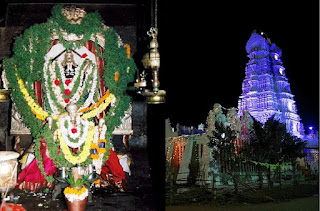Gunja Narasimhaswamy Temple
Tirumakudalu Narasipura Temple, known locally as T. Narasipura, is a panchayat town in the Mysore district of Karnataka. The first name, Tirumakudalu refers to the land at the confluence (trimakuta) of the sacred Kaveri River, the Kabini River, and Spatika Sarovara. The Spatika Sarovara, which is currently not visible, is also known as Gupta Gamini. This is the place where South India's Kumbha Mela is held every three years, and it is the abode of Sri Gunja Narasimhaswami.
Tirumakudalu Narasipura is mentioned in the Skanda Purana as being one of the Trimakuta Kshetras, or the holy places located at the confluence of three rivers. Narasipur is the name of the town itself, derived from the name of the famous Gunja Narasimhaswamy Temple, located here on the right bank of the Kaveri River.
This place is considered to be as sacred as Prayag, made holy by the confluence of the Ganges, Yamuna, and Saraswati Rivers, and is thus known as Dakshina Kashi. Tirumakudalu is where Rishi Agasthya is said to have visualized the place as Dakshina Kashi when he traveled south to Narsipur. At that time the place was a thick forest.
Enamored by the confluence of the three rivers, the rishi wanted to install a Shivalinga and asked Hanuman to get him a linga from Kashi. Due to the movement of Kala through its divine periods, Sri Hanuman was unable to get the linga on time, therefore Sage Agasthya created a sand linga and consecrated it. This caused Hanuman to be insulted, and he soon returned and cut off the top portion of the sand linga. Since that time, a perennial presence of water, said to be the water of Mother Ganga, can be found at the top of the linga. This thirtha-jala is offered to pilgrims who visit the temple. The linga that Hanuman eventually brought was consecrated a little distance away and is known as the Hanuman Linga.
There are two other lingams residing here are the Someshwara and Markandeshwara lingams. These, along with Agasthyeshwara (sand lingam) and the Hanuman lingam from the Panchalingas of T. Narsipur, said to be like the five lingams at Talakad.
The story of Lord Narasimhadev's Appearance here as Gunja Narasimhaswamy involves the dream of a washerman. While he slept, Lord Nrsimha told him that his idol lay beneath the stone on which he washed clothes every day. The Lord instructed the washerman to build a temple for him and asked him to look for gold coins beneath the stone which could be used for the temple's construction. When the washerman expressed his wish to visit (Kashi) Varanasi on pilgrimage, the Lord told him that the construction of a temple for Him had earned the washerman an additional punya (pious credit) of about a coral beed vine seed (Abrus precatorius) of that which accrues by visiting Kashi. Thus, the name Gunja came to be associated with Lord Narasimhaswamy's Name here.
Gunja Narasimhaswamy Temple is a massive complex belonging to the Vijayanagara period. The image of Lord Narasimha in the sanctum sanctorum has a weighing balance at the feet of the Deities, holding a twig with a seed of the Gunja tree, signifying the importance of the temple in association with Kasi (Varnasi), per the measure of the seed, gulaganji.
There are temple inscriptions here dating from the Krishnadevaraya period and a blend of Dravidian and Hoysala architecture. There are voluminous records in Nagari script. The temple, which is more than 500 years old, was in need of repair and restoration, and this was done under the patronage of Dr N.V. Ramanuja Iyengar from Florida.
Nearby there is the Agasthyeshwara temple. This complex contains many monuments belonging to the Ganga, Chola, Hoysala and Vijayanagara periods at Thirumakudlu. There is a chariot festival for Gunja Narasimhaswamy and Agastheswara held each year, and attended by thousands of devotees.



Comments
Post a Comment